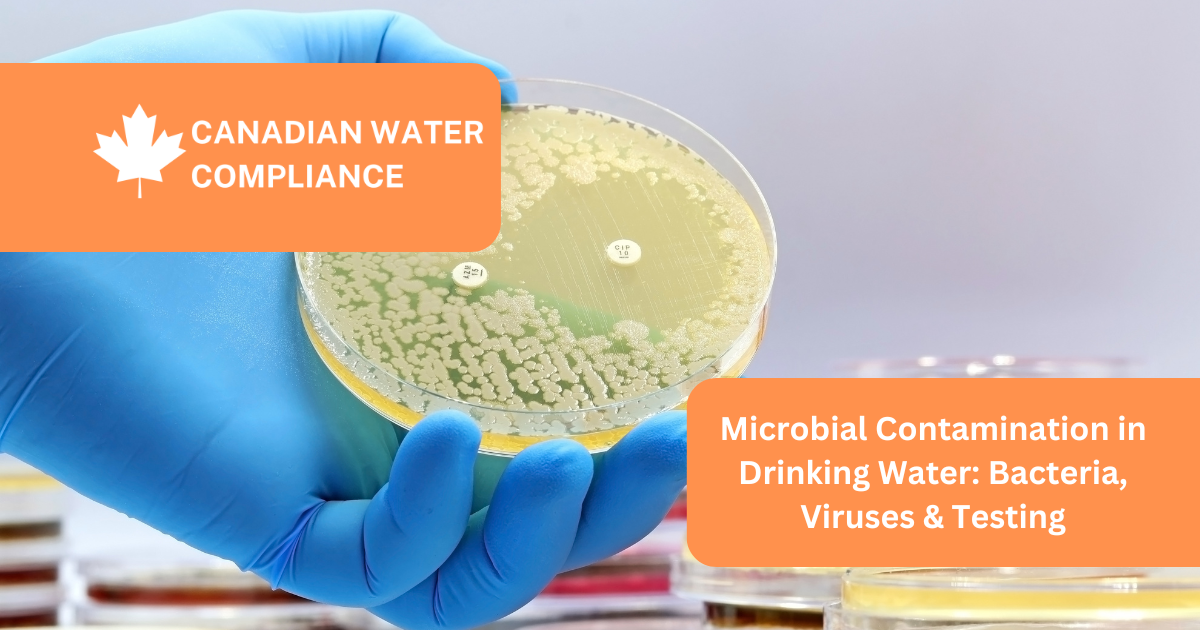
Written By: Canadian Water Compliance | On
Clean drinking water is essential for public health, yet microbial contamination remains a major concern in water systems worldwide. Even in Ontario, where strict water safety regulations exist, harmful bacteria, viruses, and parasites can infiltrate municipal supplies, private wells, and building plumbing systems.
Contaminated drinking water can cause gastrointestinal illnesses, infections, and long-term health effects, making regular testing and treatment crucial.
In this guide, we’ll cover:
What microbial contamination is and how it happens
The most common bacteria, viruses, and parasites found in drinking water
Health risks associated with microbial contamination
Testing methods to detect contamination
Treatment options for ensuring safe drinking water
Microbial contamination refers to the presence of bacteria, viruses, and protozoa (parasites) in drinking water. These microorganisms can enter water sources through:
✔ Surface Water Contamination: Runoff from agriculture, sewage overflows, and wildlife can introduce harmful microbes into lakes, rivers, and reservoirs.
✔ Groundwater Contamination: Private wells can become contaminated due to septic system leaks, manure runoff, or flooding.
✔ Aging Water Infrastructure: Old pipes, biofilm buildup, and cross-connections in water distribution systems can allow bacterial growth.
✔ Treatment Failures: Issues at water treatment plants, such as disinfection failures or pressure drops, can lead to microbial outbreaks.
🔬 E. coli (Escherichia coli)
Indicator of fecal contamination in water.
Can cause severe diarrhea, vomiting, and stomach cramps.
Certain strains (e.g., E. coli O157:H7) produce dangerous Shiga toxins, leading to kidney damage.
🔬 Coliform Bacteria
A group of bacteria naturally found in soil and water.
Presence in drinking water suggests possible sewage or animal waste contamination.
🔬 Legionella
Thrives in warm, stagnant water (hot tubs, cooling towers, plumbing systems).
Causes Legionnaires’ disease, a severe type of pneumonia.
Most at risk: Seniors, smokers, and immunocompromised individuals.
🔬 Salmonella
Found in contaminated water and food sources.
Causes salmonellosis, leading to fever, diarrhea, and dehydration.
🦠 Norovirus
Causes stomach flu symptoms (vomiting, diarrhea, cramps).
Highly contagious and spreads easily in small water systems.
🦠 Hepatitis A
Affects the liver and spreads through fecal-contaminated water.
Symptoms include jaundice, fatigue, nausea, and stomach pain.
🦠 Rotavirus
Major cause of diarrhea in infants and young children.
Often linked to contaminated water in childcare settings.
🦠 Giardia (Giardia lamblia)
Found in lakes, rivers, and poorly treated municipal water.
Causes giardiasis ("beaver fever") with symptoms like chronic diarrhea and stomach pain.
🦠 Cryptosporidium
Resistant to chlorine, making it harder to kill in traditional water treatment.
Causes cryptosporidiosis, leading to severe diarrhea and dehydration.
Even small amounts of microbial contamination in drinking water can lead to:
❌ Acute Illness – Vomiting, diarrhea, stomach cramps, fever.
❌ Severe Infections – Pneumonia (Legionella), kidney failure (E. coli O157).
❌ Long-Term Health Effects – Chronic gut disorders, liver damage (Hepatitis A).
❌ Vulnerable Populations at Higher Risk – Infants, elderly, and immunocompromised individuals.
Regular water testing is essential to ensure safety. In Ontario, both municipal water providers and private well owners should frequently test for bacteria and other contaminants.
🔍 Bacterial Testing (E. coli & Coliforms):
✔ Free testing available for private well owners through local public health units.
✔ Municipal water is tested daily, but private well owners should test at least 3 times per year.
🔍 Legionella Testing:
✔ Required for large buildings, hotels, and healthcare facilities in Ontario.
✔ Regular monitoring helps prevent Legionnaires’ disease outbreaks.
🔍 Cryptosporidium & Giardia Testing:
✔ Water treatment plants screen for these parasites, but private wells should also be tested if surface water contamination is suspected.
🔍 Viral Contamination Testing:
✔ Specialized lab testing is needed to detect viruses like Norovirus and Hepatitis A in water.
If tests indicate microbial contamination, treatment solutions are necessary.
💧 Boiling Water (Short-Term Fix)
✔ Kills bacteria, viruses, and parasites.
✔ Boil water for at least one minute (or three minutes at high altitudes).
💧 Chlorination & Disinfection
✔ Municipal systems use chlorine to kill bacteria and viruses.
✔ Private well owners can use shock chlorination or UV light purification.
💧 Ultraviolet (UV) Water Purification
✔ Destroys bacteria, viruses, and protozoa without chemicals.
✔ Ideal for private wells, rural homes, and commercial properties.
💧 Reverse Osmosis (RO) Filtration
✔ Removes bacteria, viruses, and some protozoa through membrane filtration.
✔ Often combined with carbon filtration for extra safety.
💧 Distillation
✔ Boils water to remove pathogens and most contaminants.
✔ Used in laboratories, hospitals, and high-risk environments.
Microbial contamination in drinking water poses serious health risks, but regular testing, treatment, and proper maintenance can ensure safe water for homes and businesses.
📌 For municipal water users – Be aware of boil water advisories and maintain household plumbing to reduce risks.
📌 For private well owners – Test your water at least three times a year, and consider UV purification or chlorination.
📌 For businesses & healthcare facilities – Regular Legionella testing and water system disinfection are crucial.
🚰 Need professional water testing or treatment? Contact Canadian Water Compliance today for expert solutions!